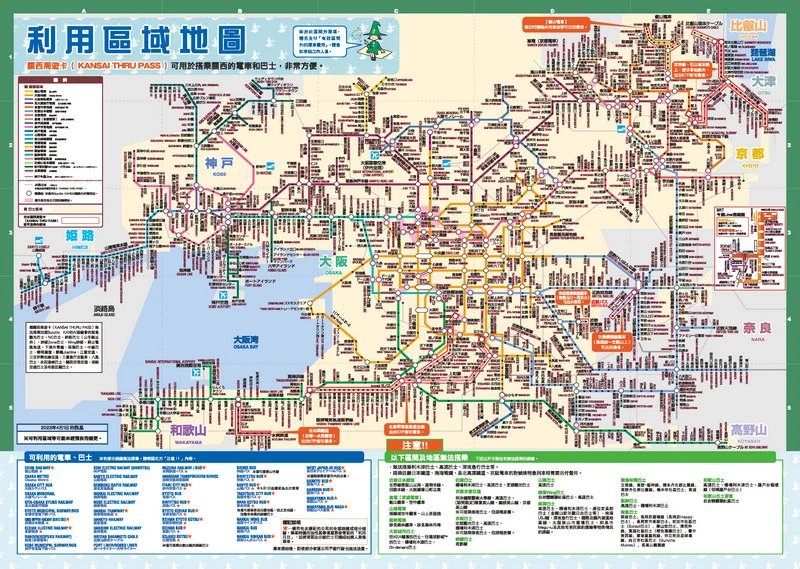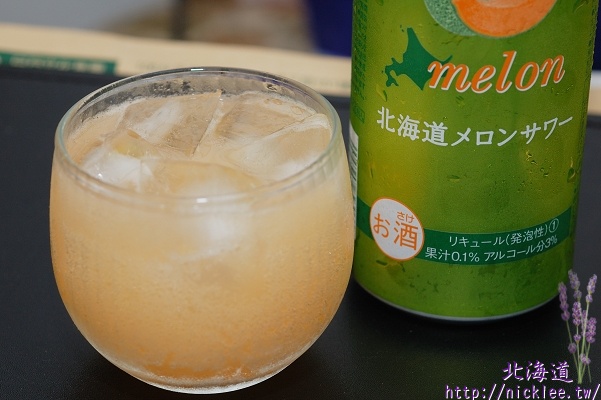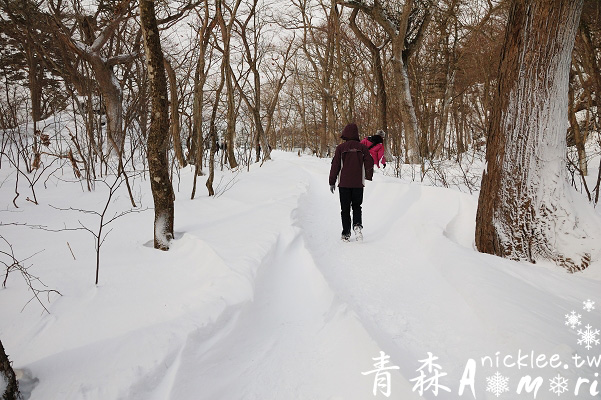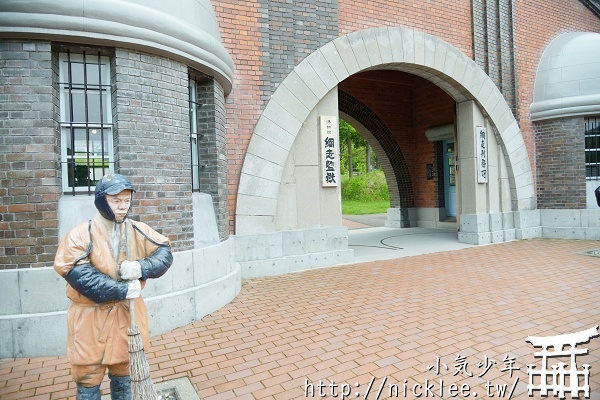This article is about how to understand the Kansai Thru Pass map, which is used in conjunction with the Kansai Thru Pass. If you don’t plan on using this transportation ticket, you can skip reading it. However, if you do plan on using the Kansai Thru Pass, it’s important to understand how to read this map to avoid any confusion about its coverage area.

KANSAI Travel Guide
This is the Kansai Private Railway Alliance Organization (this name is self-made), but calling it a private railway is not quite accurate because it also includes bus companies. Anyway, more and more transportation companies are joining, making it the largest transportation organization in Kansai. This organization issues transportation tickets that make it convenient for travelers to transfer between different transportation companies without carrying a bunch of coins. The main things it issues are:
1. Pitapa contactless rechargeable card, but it’s not easy for tourists to apply for, so I won’t introduce it. (ICOCA has collaborated with Pitapa and can be used interchangeably). The usage method is to simply tap the card.
2. Surutto KANSAI Card (Fixed Fare Prepaid Card) is a prepaid card issued by various affiliated companies. It cannot be recharged. To use it, simply insert it into the card reader.
3. Kansai Thru Pass, also known as KTP, is available in 3-day and 2-day versions. To use it, simply insert the card into the card reader or refer to the back of the card for certain transportation options.
Regarding the first and second points, let’s skip them directly. As for the third point, you can refer to a brief introduction of the Kansai Thru Pass.
How to obtain a Kansai Thru Pass map
You can obtain the English version of the Kansai Thru Pass map from the official website: click here to download the Traditional Chinese version, and click here to download the Simplified Chinese version.
Teaching you how to read the Kansai Thru Pass map.
This map is divided into four parts.
1. The first part is the illustration and explanation, which explains the transportation units represented by different colored lines on the route map.
2. It lists the transportation companies that can be used, including railways and buses.
3. Within the usable range, transportation companies that do not accept KTP are not allowed.
4. The last part is the entire transportation route map.

1. Legend/Illustration Section
This part is to tell you the railway companies represented by the different colors on the route map.
Within the yellow area, this is the bus usage range, which means that buses within 2. can be used, except for 3.
In the red box, it indicates that when using KTP, simply present the back of the card to the driver or station staff for inspection. If it is the first time using it, the station staff will write the date of the day on the back of the card with a permanent marker.
In addition, the main stations are indicated by a white background with black circles. This means that these stations have more than one route, so you can transfer here. The pink-colored area represents different stations, but you can transfer between these two or more stations.

Bus Usage Range / The range where you need to present the ticket on the back in order to board the bus.
In the Nara region, there is a small portion at the bottom that is yellow, indicating that the Nara transportation buses in this area can accept KTP. Additionally, the section highlighted in red is where you need to show the back of the card to the station staff when using KTP for this route.

Transfer Station
When it comes to transferring stations, you can transfer at Namba Station on the Midosuji Line and Yotsubashi Line of the Osaka Subway, and then transfer again at Osaka-Namba Station for the Kintetsu Railway and Hankyu Railway, as well as at Namba Station for the Nankai Electric Railway.
In addition, speaking of the Shinsaibashi Station and Yotsubashi Station on the Osaka subway, although these two stations are not physically connected, they are interconnected through a passage, allowing passengers to transfer between them. Hence, there are such signs…
The orange line in the picture represents the Osaka subway, the blue line represents the Kintetsu train, the blue-green line represents the Hanshin train, and the green line represents the Nankai Electric Railway.

2. Available Trains and Buses

Due to these reasons, I will reiterate the explanation I provided in another article, “Introduction to Kansai Thru Pass,” as follows:
Trains and subways
Simply put, any route that appears on the map can be taken using KTP. This includes the Eizan Electric Railway, Osaka Metro (subway + new tram + BRT), Osaka Monorail, Kitakyu Nishinomiya Electric Railway, Kyoto Municipal Subway, Kintetsu (★), Keihan Electric Railway (★), Randen (Keifuku Electric Railroad), Kobe Municipal Subway Kobe Electric Railway, Sanyo Electric Railway, Semboku Rapid Railway, Nankai Electric Railway, Nose Electric Railway, Hankai Tramway (★), Hankyu Railway, Hanshin Electric Railway, Hieizan Sakamoto Cable Car, Port Liner (ポートライナー), Rokko Liner (六甲ライナー), and Suito Railway
(partially ★, indicating that the company has a portion of the operating section where the ticket inspection method involves showing the card to station staff or the driver).
Bus Section
Osaka City Bus, Kyoto City Bus, Kobe City Bus, Mizuma Railway Bus, Nishinomiya Transportation Promotion, Itami City Bus, Kyoto Bus, Kintetsu Bus (★), Keihan Kyoto Bus (★), Keihan Kyoto Traffic (★), Keihan Bus (★), Ejiro Eki (★ – can only take buses on the Hieizan Line), Kamikami Bus (can only take the Yamanote Line), Kamitei Bus (★), Sanyo Bus (★), Takatsuki City Bus, Nara Transportation (★ – can only take buses in Nara Park area, Nishinokyo area, and Horyuji area), Nankai Tsubasa Bus, Nankai Bus, Nankai Forest Bus (★), West Japan JR Bus (★ – can only take buses within Kyoto city), Hankyu Bus (★), Hanshin Bus (★), Wakayama Bus (★), Wakayama Bus Naga (★)
(The ★ indicates that the company has a partial fare collection method for certain operating routes, where passengers need to show their card to station staff or drivers for inspection).
3. Restricted Areas
The main thing is that you cannot take the Limousine Bus, Express Bus, or Late Night Express Bus. Additionally, for designated seats on the Kintetsu, Nankai Electric Railway, Semboku Rapid Railway, and Keihan Electric Railway, an additional fee is required.
Other common routes that cannot be taken include: Keihan Kyoto Kotsu – Sonobe Miyama Line, Kyoto Miyama Line, Eizan Cable Car, Eizan Ropeway, and buses to IKEA or Universal Studios from Mt. Hiei.

Supplementary Explanation – Back of the Kansai One Pass
On the back of the KTP, the red frame is where the station staff will write the date. Is it written at every station? Of course not. It refers to the areas on the map where there are no ticket machines. Only in those areas, such as the Keihan Electric Railway’s Ishiyama Sakamoto Line, or the Biwako Valley’s Sakamoto Mountain Train, or Nara Kotsu…

Reference Materials
■ Introduction to Kansai Thru Pass
■ Kansai Thru Pass Official Website
For more information on transportation in Osaka, Kobe, Kyoto, and Nara, please refer to the Kansai Transportation Guide page.
『Original Source:https://nicklee.tw/1011/』





